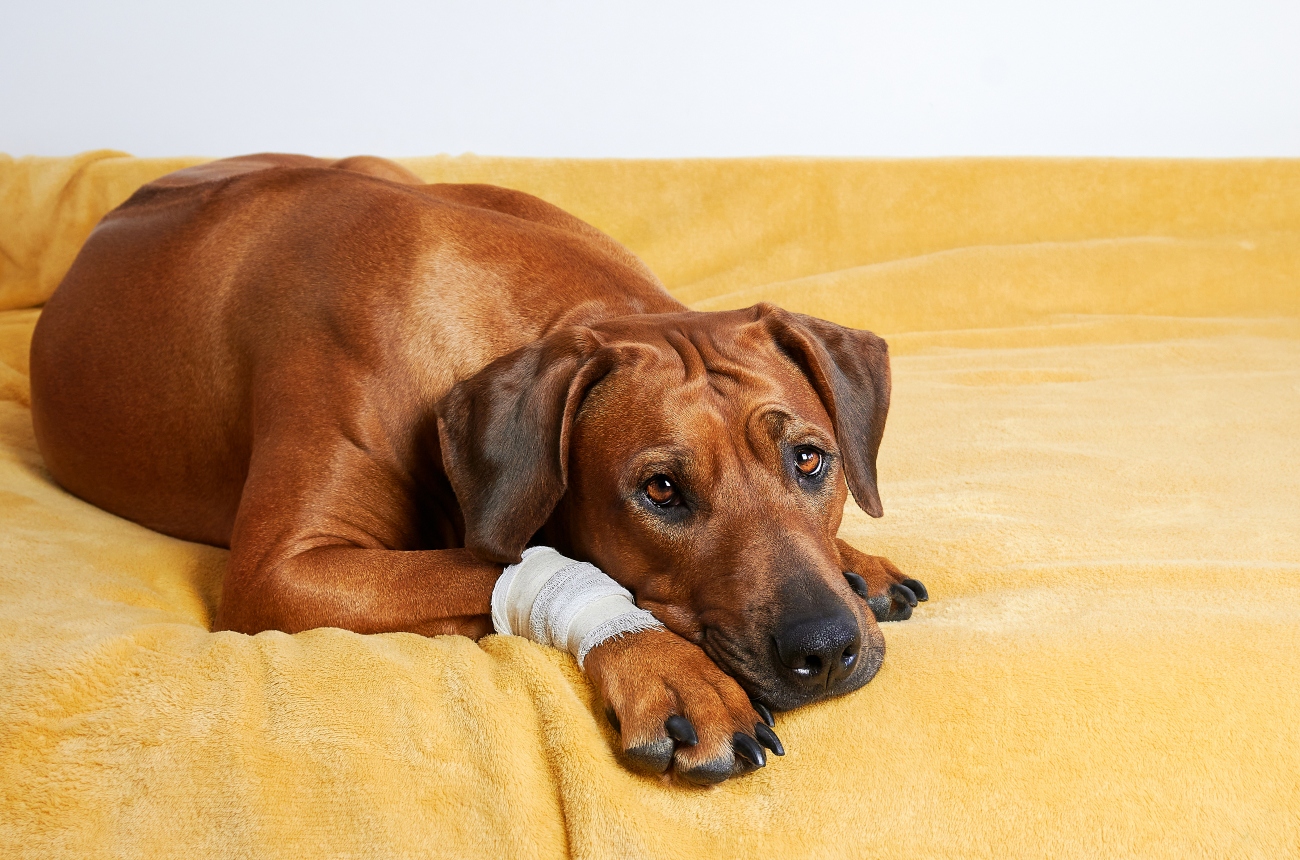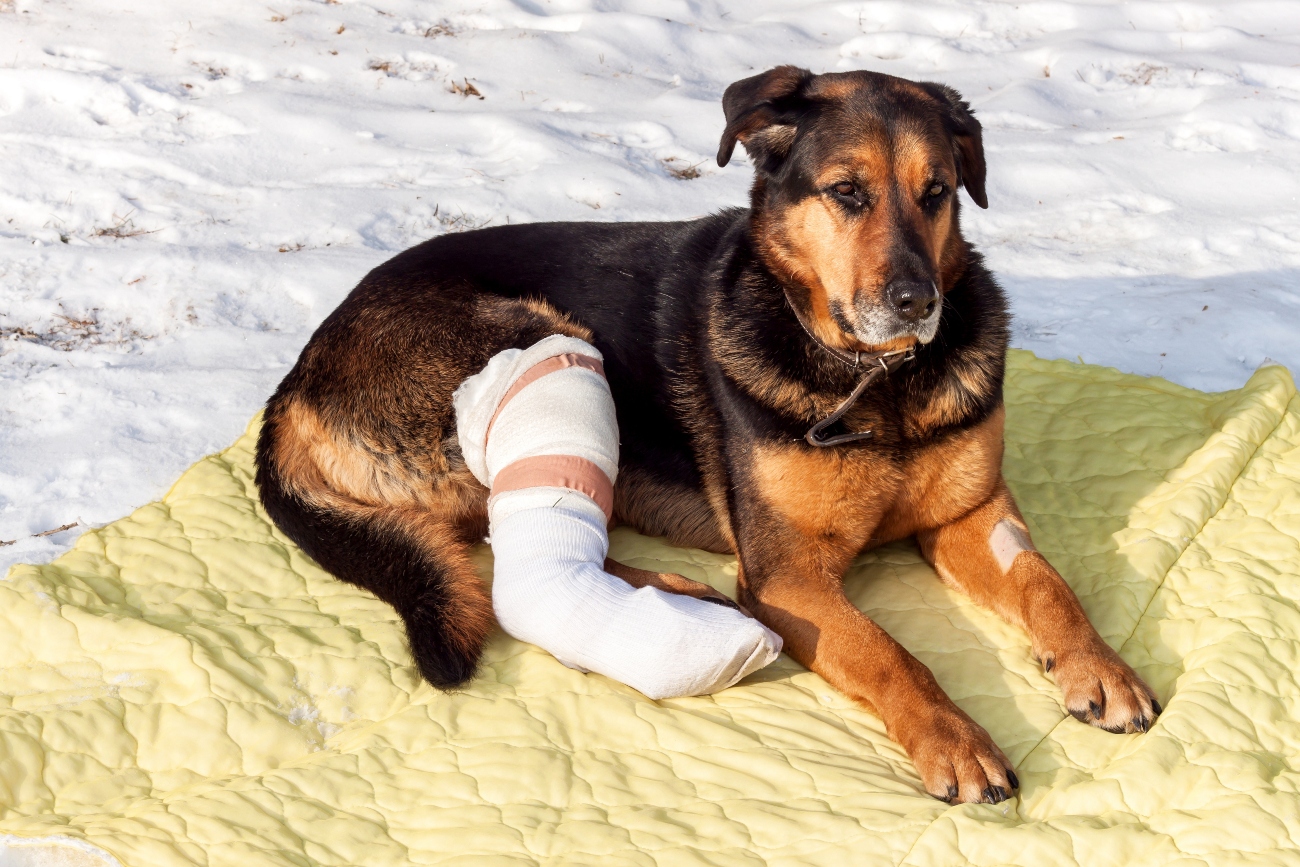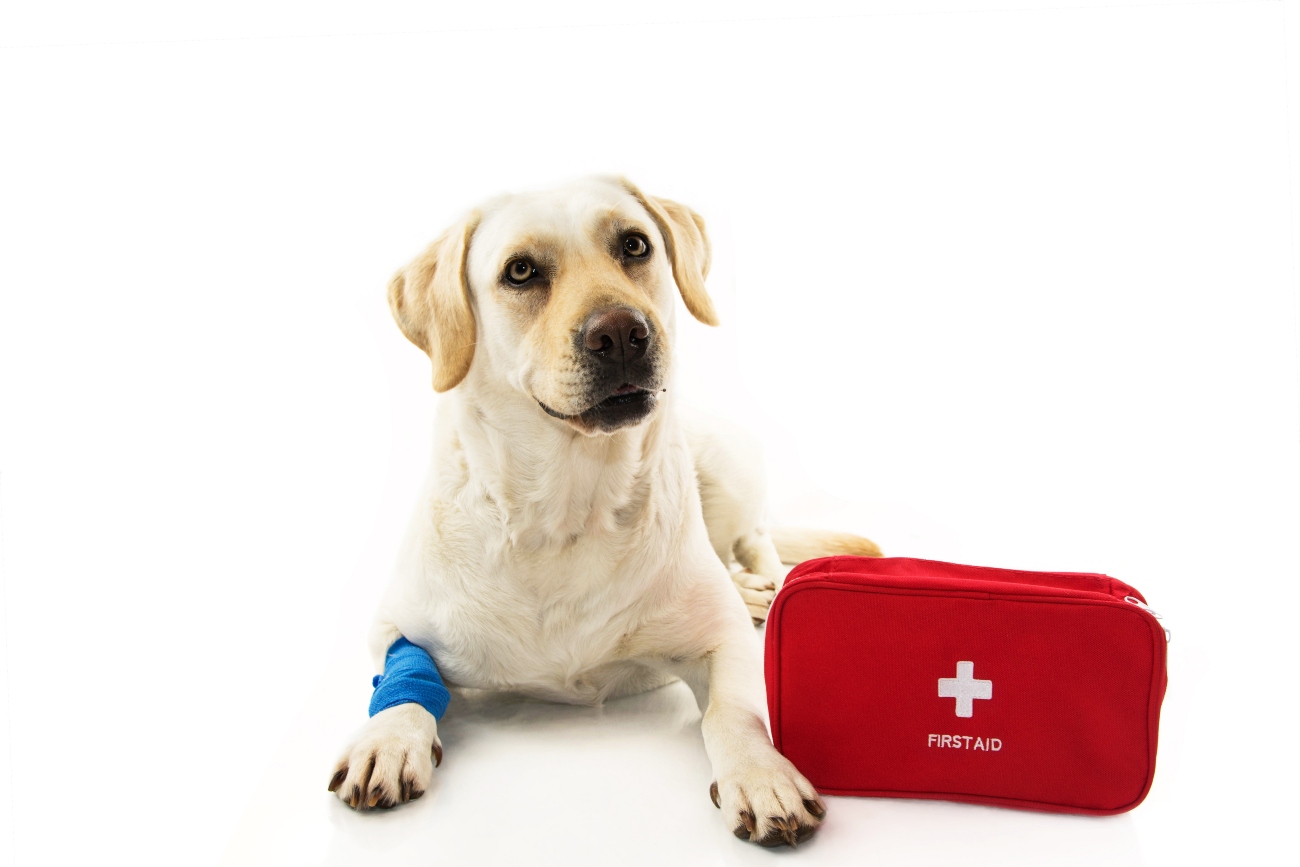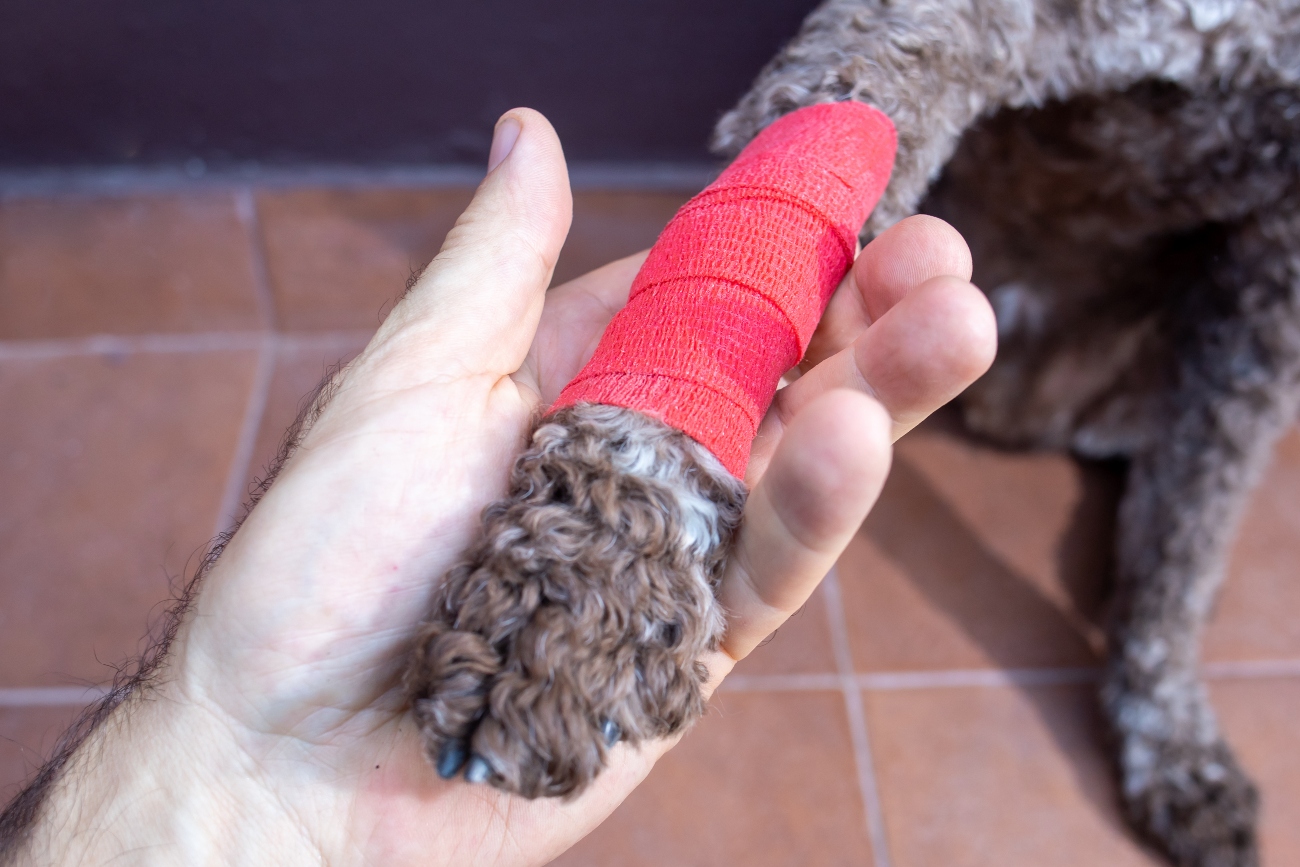
How to care for a dog with a broken bone
18th August, 2022
Broken bones are a common injury requiring a visit to the vet. If you notice your dog seems to be in pain or is suffering with lameness, it could be they’ve broken something – especially if they’re getting on in years and not as agile as they once were. Read our Petwise guide on how to care for a dog with a broken bone so you know exactly what to do if this happens to your trusted friend.

Knowing all you can about your dog’s health is an important part of responsible pet ownership. Petwise is a great place to find old dog pet insurance just right for your canine’s needs and budget.
It’s also a huge resource, full of the latest news in the pet world, and informative blogs and guides. Why not take a read when you’re next looking for great value insurance cover?
Common bone breaks in dogs
Just as with any animal, bones are usually broken by a sudden impact or large force applied to the body. This is often caused by an object such as a moving car or due to a fall from a height.
Bone breaks tend to occur most often in older dogs (whose bones may be more fragile) and in more adventurous and excitable dogs (who tend to get themselves into more dangerous circumstances).
According to the Kennel Club’s broken bone guide, the most common bone breaks in dogs are the femur, pelvis, skull, jaw and spine. Although pretty much any bone can be broken including ribs, toes and even tails.
Some of these breaks can be difficult for even trained veterinary professionals to manage – imagine trying to deal with a broken tail that won’t stop wagging!
How to spot a broken bone
Dogs are hardy creatures and will often show a high tolerance for pain. Sometimes this means that a broken bone could even go unnoticed, especially if your older dog is limping with old age anyway.
That’s why it’s important to look out for tell-tale symptoms to indicate the presence of a fracture. Watch out for things like:
Open wound, exposed bone or bruising
This isn’t always the case with fractures, but some will be very obvious.
Sudden lameness or limping
Apart from fractures, there are many causes of lameness in older dogs. Read this Petwise guide to find out more.
Problems walking or running normally
Your dog might try holding up the affected limb to avoid putting weight on the injury. This could mean the limb itself is broken or that another bone connected to the area is making movement of that body part painful.
Restricted movement
In general, dogs have excellent mobility and are very active creatures. Whether curling up to groom hard-to-reach areas, jumping over tall fences, or racing around the park at breakneck speed, they’ll make you tired just watching them. However, with a broken bone these movements could become impossible and very painful.
Any dog that seems reluctant to move needs further assessment from a professional.
Changes in normal behaviour
Having spent so much time together you’ll have an excellent idea of what is normal behaviour for your dog. For example, a previously greedy hound who is now reluctant to eat is worrying.
You need to find out why.
If they’ve broken their jaw then chewing their food could be extremely painful.
Increased vocalisation
Every dog is different and while some might suffer in silence, others will bark more often, or even whine and cry. Some dogs might also find a quiet spot in which to hide away.
Swelling
Broken bones cause inflammation. If you notice any swelling then give your vet a call or ring the Petwise 24-Hour Vet Helpline.
Deformity with shortening of the limb
A limb may look out of place. This could be a sign something is seriously wrong and needs immediate attention.
If you notice any of these symptoms then be sure to keep your dog hydrated. An injured animal will often avoid food and drink and this can lead to further problems if left untreated.
Be aware that abscesses, embedded grass seeds and muscle and ligament injuries can also cause similar symptoms and pain levels.
Even if it isn’t a broken bone, it’s still vital to get them seen by a vet as soon as possible.
An additional benefit for policyholders who have old dog pet insurance through Petwise is our 24-Hour Vet Helpline. Staffed by veterinary professionals, it’s a quick and easy way to get some advice on all manner of pet-related worries.
What types of fractures are there?
Bones can fracture in a number of different ways, which require a different approach when it comes to treatment. Some can be much more complicated than others.
Closed fractures
These are where the broken bone has not penetrated through the skin. No extremal wound is present.
Open fractures
Also known as compound fractures, in this situation there will also be an open wound present. The broken ends of the bone will have pushed through the skin layers and created a wound.
In some extreme cases, there may even be a piece of bone sticking out through the skin.
Sometimes, the blow that caused the wound was so forceful that it penetrated the flesh and caused the bones beneath to break.
Because the wounds will often be contaminated by dirt or bacteria these can be more complicated as they carry a high risk of infection. If there is an infection present then it can take longer for the bone to heal.
Incomplete fractures
One of the less complicated fractures to treat. As the name suggests these are only partial bone breaks. Seen on an X-ray the fracture line won’t extend all the way through the bone and the bone will have remained in one piece. With appropriate treatment these should heal more quickly and easily than other types.
Complete fractures
When the bone is completely broken into two or more pieces then it’s called a complete fracture.
Complete fractures are typically categorised into the following types.
- Stable fracture: The broken ends of the bone still line up and are barely out of place.
- Transverse: The bone has a horizontal fracture line straight across it.
- Oblique: The bone has been broken at an angle and the broken ends are pointed.
- Comminuted: The bone is split into three or more pieces.
As you can imagine, treatment of broken bones can become very expensive for your older dog. If you’re worried about how you would care for your beloved old-timer if they broke a bone then give our friendly UK-based team a call.
They’ll take you through all you need to know when it comes to arranging old dog pet insurance.
Top tips for dealing with a suspected broken bone
While a broken bone is not usually an immediate threat to your dog’s life, it’s still a serious injury that requires prompt treatment. This is especially true if your dog is getting on in years and might have other health conditions.
Or if they were injured in some kind of accident where there could be additional internal injuries that aren’t immediately obvious.
As with any injury to your beloved pet, your primary objective is to reduce pain and risk of further injury. And if it’s an open fracture to avoid the wound becoming infected as well.
If you suspect your dog has broken a bone, here are some top tips to bear in mind:
- Keep calm. Your dog may be scared and in pain but you need to stay calm to handle the situation.
- Move your dog as little as possible. But do get them to a safe location.
- A dog with a broken bone will be in pain and could become anxious and aggressive. It might be necessary to muzzle them to keep everyone safe.
- If it’s an open fracture, never try to push bones back in or apply sprays, antiseptics or ointments. Simply cover with clean gauze, T-shirt or towel.
- If there is continued bleeding then apply only gentle pressure.
- Don't try to reset the bone yourself. In fact, avoid manipulating the broken limb at all as this will cause pain and may damage surrounding tissues.
- Get your dog to your vet immediately.
- Bring help when transporting your dog, so you can focus on the road.
- During travel try keeping broken limbs elevated using towels. Use pillows or bulky blankets to cradle the limb and keep the fracture stable.
- Keep them warm to prevent shock.
- Give your old dog pet insurance provider a call to make sure treatment is as quick as possible.
How do you treat a dog’s broken bone?

The way in which your vet will treat the fracture depends on a whole range of factors. As well as your dog's age, size and fitness, they’ll also need to consider what bone has been broken and the type of fracture it is.
To help with assessment your dog will probably need an X-ray of the injured area. This may also involve sedating them and giving them medication to control the pain. They may also need to be given anti-inflammatory medication and antibiotics.
Repairs to broken bones can cost thousands of pounds, and sometimes the limb may even need to be amputated. Whatever the type of the fracture, repair is usually only undertaken once the patient has been stabilised and the risk of infection is controlled.
This could be days after the initial injury.
Your dog’s broken bone may be treated with just a splint or a cast. But depending on the type of fracture surgery may need to be undertaken to bring the broken bone edges back together so they can knit firmly and heal. To do this may even require the use of pins, screws, metal plates and wire to maintain the position of the bones as they heal.
This can soon get complicated and expensive!
How to help and support your injured dog at home
After your dog’s bone has been repaired and they’ve been sent home, the treatment doesn’t stop there. Your dog will need a lot of time to recover.
Aftercare at home is a vital part of your canine’s recovery process. After all, an improperly healed bone can cause lifelong problems for a dog and may even require further treatment or surgery. Once you’ve gone to the effort of getting the best medical care for your pooch it’s important to follow any instructions your vet gives you.
These could include:
- Giving the right doses of medication. Your dog will probably be prescribed medication to make them comfortable following treatment. You might also need to give them antibiotics or anti-inflammatory medications to prevent any further infection and to reduce swelling. This is particularly the case if they have had surgery.
- Ensuring they have plenty of rest. Even older dogs are active creatures and will be used to exercising regularly. So, one of the most difficult home care tasks is ensuring they rest enough. After a few days of rest and recuperation your dog may well think they’re able to run around and play just like they used to. Unfortunately, doing so could aggravate the injury and prevent it from healing. You might have to put away the lead and their favourite toys for a few weeks.
- Ensuring bandages are kept dry and clean. If your dog has been left with a wound either from the injury or from surgery then it needs to be kept clean and dry with bandages. Particularly as wounds begin to heal, they can start to itch. You’ll need to stop your dog from scratching at them. Is it time for the dreaded cone of shame?
- Organise follow-up appointments. Your vet will probably want to take more X-rays to check the bone is healing properly.
- Attend physiotherapy. Enforced rest for several days or weeks will inevitably make joints stiffen up. But it can also make muscles shrink and even delay healing of the bone. You may be advised to see a physiotherapist to get guidance on promoting limb use without causing further damage.
- Other home treatments. There are lots of things worth trying including cold therapy, motion therapy, hydrotherapy and massage therapy. Remember to speak to your vet before trying any of these.
Caring for a dog with a broken bone can be challenging. But it’s also useful to remember that by having old dog pet insurance arranged through Petwise, there’s always help close at hand.
Are some dogs more susceptible to broken bones than others?
All breeds of dog can break bones, but they do seem to happen most often in older dogs and puppies.
Some breeds are more susceptible to breaks owing to their size. For example, so-called Toy breeds with smaller limbs can be seriously injured just by falling from an owner's arms or by being accidentally trodden on.
There have also been some reports of certain breeds being more susceptible to particular bone breakages. For example, according to recent research from the Royal Veterinary College, French Bulldogs are eight times more likely to suffer an elbow fracture than cross breed dogs.
5 ways to strengthen your dog’s bones
Whether or not your old dog has broken a bone, it’s still worth reviewing their diet and exercise needs. While our beloved pets need the same things we do for healthy bones, such as calcium and vitamin D, there are some canine-specific things you can do to strengthen your dog’s bones.
-
Find a high quality, balanced dog food
Meeting your dog’s nutritional needs has to be a number one priority when it comes to bone and joint health. Do this by finding a nutritionally balanced dog food filled with just the right vitamins and minerals perfect for their specific needs. -
Watch the portion sizes
Dogs who overeat and put on weight are much more likely to suffer from joint problems. Not only is this important when they’re young and developing, but also when they’re getting older. That said, if your dog doesn’t eat enough, then they could fall short of what they need. Always follow portion size recommendations as closely as possible. Also keep a close eye on your dog’s body condition – you might need to fine tune the amounts as they get older and their nutritional needs change. -
Follow a consistent exercise regimen
Every dog needs regular exercise to keep them fit, healthy and happy. Regular walks and an occasional run around the park are usually enough to take care of bone health. However, be careful not to push dogs too far. A pint-sized pug is never going to reach the distances that an energetic Labrador can put in. Too much exercise can create bone or joint complications for your older dog, too. -
Omega 3 could help with bone and joint problems
Research suggests that dogs who are already suffering from bone and joint problems could benefit from Omega-3 fatty acid supplements. -
Plenty of protein
A dog’s bones are largely made up of protein, so it’s essential they get the right amount of this ingredient in their diet. If not, their bones will get weaker and become more susceptible to breaks.
To help keep your trusty canine companion happy and healthy, old dog pet insurance arranged through Petwise includes a senior food contribution.
What other bone problems affect dogs?
Maintaining great bone health is essential for a pet’s wellbeing. Not only does it help prevent fractures but it also guards against a wide variety of bone diseases.
These include:
-
Arthritis
Most commonly seen in senior dogs, arthritis refers to painful inflammation of the joints. -
Osteomyelitis
This is a bone infection which normally results following a traumatic injury, such as an open fracture. -
Metabolic disorders
The most common disorders of this type seen in dogs are panosteitis, osteochondrosis, and hypertrophic osteodystrophy. -
Bone cancer
Unfortunately bone tumours are often missed as they can be mistaken for arthritis or other injuries. That’s why it’s so important to get your pet checked out, even if you don’t think it’s anything to worry about.
Get old dog pet insurance from Petwise

The good news is that with the right care, dogs can quickly recover from even serious injuries and illnesses. At Petwise we believe that every dog deserves the very best protection available.
That’s why we offer a choice of cover levels for old dog pet insurance and include dental cover on all policies*.
Find your old dog pet insurance today. It’s so easy with Petwise.
*Subject to annual dental check